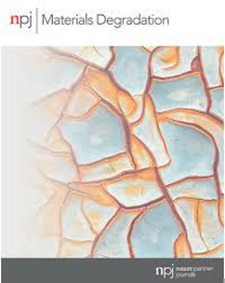Effects of open circuit immersion and vertex potential on potentiodynamic polarization scans of metallic biomaterials
IF 6.6
2区 材料科学
Q1 MATERIALS SCIENCE, MULTIDISCIPLINARY
引用次数: 0
Abstract
Electrodes made of commercially pure titanium (CP-Ti) and a CoCrMo alloy are immersed at an open circuit in a phosphate buffer saline electrolyte at room temperature for different durations prior to electrochemical analyses. Open circuit potential measurements, electrochemical impedance spectroscopy measurements, and cyclic potentiodynamic polarization (CPP) scans are used to assess the impact of the immersion time on derived property values. Stable passivation layers formed on both materials during immersion. The corrosion potentials determined from the anodic legs of CPP scans become more cathodic, and the corrosion currents decrease to lower values after longer immersion times. Measured currents indicate the layers formed on CP-Ti stabilize during forward anodic scans and persist to the vertex potential, whereas passivation breakdown occurs during anodic scans with CoCrMo with active corrosion at voltages up to the vertex potential. The characteristics of the return cathodic legs of CPP scans represent the surface conditions at the vertex potential: characteristic corrosion property values derived from the test responses represent passive surfaces on CP-Ti and leached surfaces on CoCrMo rather than intrinsic properties of those materials.

开路浸泡和顶点电位对金属生物材料电位极化扫描的影响
在进行电化学分析之前,将商用纯钛(CP-Ti)和 CoCrMo 合金制成的电极在室温下开路浸泡在磷酸盐缓冲盐水电解液中,浸泡时间长短不一。开路电位测量、电化学阻抗光谱测量和循环电位极化(CPP)扫描用于评估浸泡时间对衍生属性值的影响。两种材料在浸泡过程中都形成了稳定的钝化层。根据 CPP 扫描阳极段确定的腐蚀电位在浸泡时间延长后变得更加阴极化,腐蚀电流下降到较低值。测量到的电流表明,CP-Ti 上形成的腐蚀层在正向阳极扫描过程中趋于稳定,并持续到顶点电位,而 CoCrMo 在阳极扫描过程中会发生钝化破坏,在电压达到顶点电位时会发生活性腐蚀。CPP 扫描的返回阴极段的特征代表了顶点电位的表面状况:从测试响应中得出的腐蚀特性特征值代表了 CP-Ti 的被动表面和 CoCrMo 的浸蚀表面,而不是这些材料的固有特性。
本文章由计算机程序翻译,如有差异,请以英文原文为准。
求助全文
约1分钟内获得全文
求助全文
来源期刊

npj Materials Degradation
MATERIALS SCIENCE, MULTIDISCIPLINARY-
CiteScore
7.80
自引率
7.80%
发文量
86
审稿时长
6 weeks
期刊介绍:
npj Materials Degradation considers basic and applied research that explores all aspects of the degradation of metallic and non-metallic materials. The journal broadly defines ‘materials degradation’ as a reduction in the ability of a material to perform its task in-service as a result of environmental exposure.
The journal covers a broad range of topics including but not limited to:
-Degradation of metals, glasses, minerals, polymers, ceramics, cements and composites in natural and engineered environments, as a result of various stimuli
-Computational and experimental studies of degradation mechanisms and kinetics
-Characterization of degradation by traditional and emerging techniques
-New approaches and technologies for enhancing resistance to degradation
-Inspection and monitoring techniques for materials in-service, such as sensing technologies
文献相关原料
| 公司名称 | 产品信息 | 采购帮参考价格 |
|---|
 求助内容:
求助内容: 应助结果提醒方式:
应助结果提醒方式:


